Buttermilk French Toast
Updated March 2020 with new photos.
Thick pillow-ey pieces of French bread are soaked in a Grand Marnier infused buttermilk custard, then fried to golden perfection. The flavor profile of this Buttermilk French Toast is unique but also classic enough to bring back great feelings of nostalgia. Perfect for a comforting weekend breakfast!
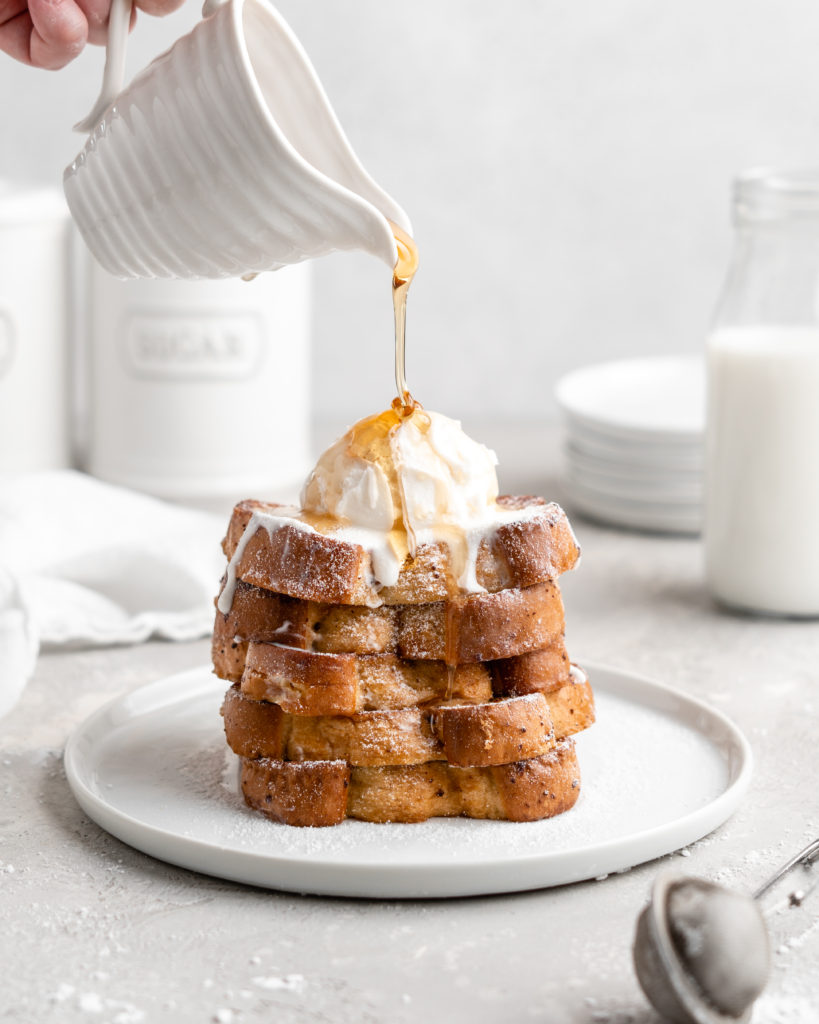
French toast has always been one of those things that I kind of knew how to do, but was never, by any means, good at it. It was something I would make when we had leftover white bread in our house that was on the verge of being too stale to do anything else with. I would essentially whisk up an egg with some skim milk, add a touch of cinnamon, and quickly dip my thin white bread in it. While this method and recipe surely worked in a pinch and was definitely a good use for stale bread, it never lived up to the French Toast that I would get in restaurants. Restaurant French Toast was always so flavorful, moist and pillow-ey, yet still had fantastic structure and crunch. I thought, “it must just be the bread”. I then went out and bought a beautiful loaf of French bread from my local bakery, tried the same method and recipe. Ahh! It was soggy! I know where I went wrong – the bread needs to be stale. I attempted the same recipe and method yet again, but with stale bread, however this time it was too dry!
Tips for the Perfect Buttermilk French Toast
Alas, after doing a little more research, I realized there was so much more to French Toast than I ever imagined. Then by testing and tasting different methods – seeing what gave the best overall texture and taste, I have compiled several tips and tricks on how to perfect Buttermilk French Toast, along with an excellent recipe.
• Use stale bread. stale bread absorbs the custard much better, without leaving the bread over-moist and soggy. Fresh bread WILL turnout soggy and will likely fall apart as well. The best way to get stale bread is to cut it into slices the night before, and leave it out on the counter, uncovered, for at least 8 hours. If you forgot to leave it out the night before, simply cut the loaf into slices and place into the oven at 250°F for around 20-25 minutes.
• Use good bread and thick slices. The bread-type for French Toast needs to be quite sturdy, allowing it to hold its shape even after being soaked in custard. Brioche, French Loaf, and Challah are all excellent. Furthermore, when you slice the bread, the slices should be ¾” to 1” thick, that way they can absorb enough custard to be flavorful and soft. Too thick = dry center, too thin = soggy.
• Strain your beaten eggs. This is simply just to remove any chunks of eggs. I don’t know about you, but one of the most unappealing things to me when being served French Toast, is when there is a large streak of cooked egg white on it. I find these chunks of egg white can also take away from the overall taste of the French Toast, as it can sometimes leave an eggy taste in your mouth. By straining the beaten eggs, you will remove any odd chunks, leaving you with a silky-smooth custard.
• Use buttermilk instead of regular milk for french toast. This has to do with the thickness and flavor of buttermilk. The viscosity of buttermilk is much higher than that of milk, leading to a thicker custard. Furthermore, buttermilk tends to add an extra dimension of flavor, which is excellent in a dish with so few ingredients.
• Room temperature custard is recommended. The reduced temperature difference between the custard-soaked bread and the pan will reduce the likelihood of the egg congealing into a solid. While this is recommended, even I don’t always do this – I mean who has the time? However, you can bring the ingredients up to room temperature by placing them into warm water beforehand.
• Soak the slices for 30-40 seconds per side (I do 30 for ¾” and 40 for 1”). Then place onto a wire rack, allowing them to rest for an additional 5 minutes. This is crucial to excellent buttermilk French toast. By allowing the slices to rest, it allows the custard to soak into the center, leaving a uniformly soaked slice.
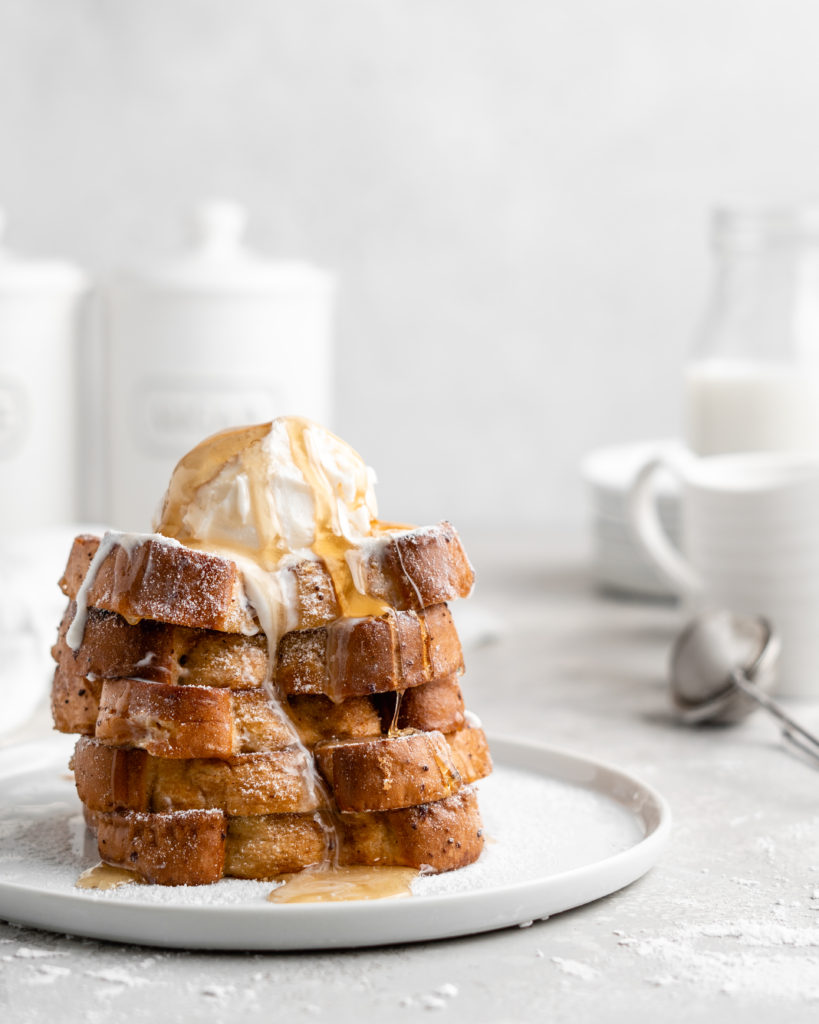
• Use butter AND oil for frying. The butter lends a great taste to the frying process, but butter also has a very low smoke point, which means that it will burn easily. By adding oil, you are increasing the smoke point, while retaining that flavor dimension. Make sure to use an neutral-flavored oil with a high smoke point. Canola oil is perfect, as well as grapeseed oil!
• Do not get overzealous and try to cook in on a high temperature. The outside will burn, while the inside will not cook or set.
• You can place the slices into the oven to keep warm, at 375°F for 5 minutes, after cooking. This allows the custard to actually set up even better on the inside. However, I do not always do this either. If you have hungry people waiting, feel free to just serve as you go.
• Don’t skip the alcohol! Okay well you can if you don’t have it, but I really recommend trying it! The Grand Marnier, adds a beautiful dimension to this recipe. During the cooking process, the alcohol is cooks off, leaving behind a delicious and slightly orange essence – really complimenting the cinnamon and nutmeg in the recipe. Since I tried it this way, I have not gone back, and I promise you will not either!
• Lastly, the sugar in this recipe can be adjusted up or down. If you only have butter, or English cream, or whip cream on your Buttermilk French toast, you way enjoy a little more sugar in the recipe (1/2 cup is great!). However, if you tend to douse your French toast with sugar or maple syrup, the sugar can easily be cut down, to say about ¼ cup.
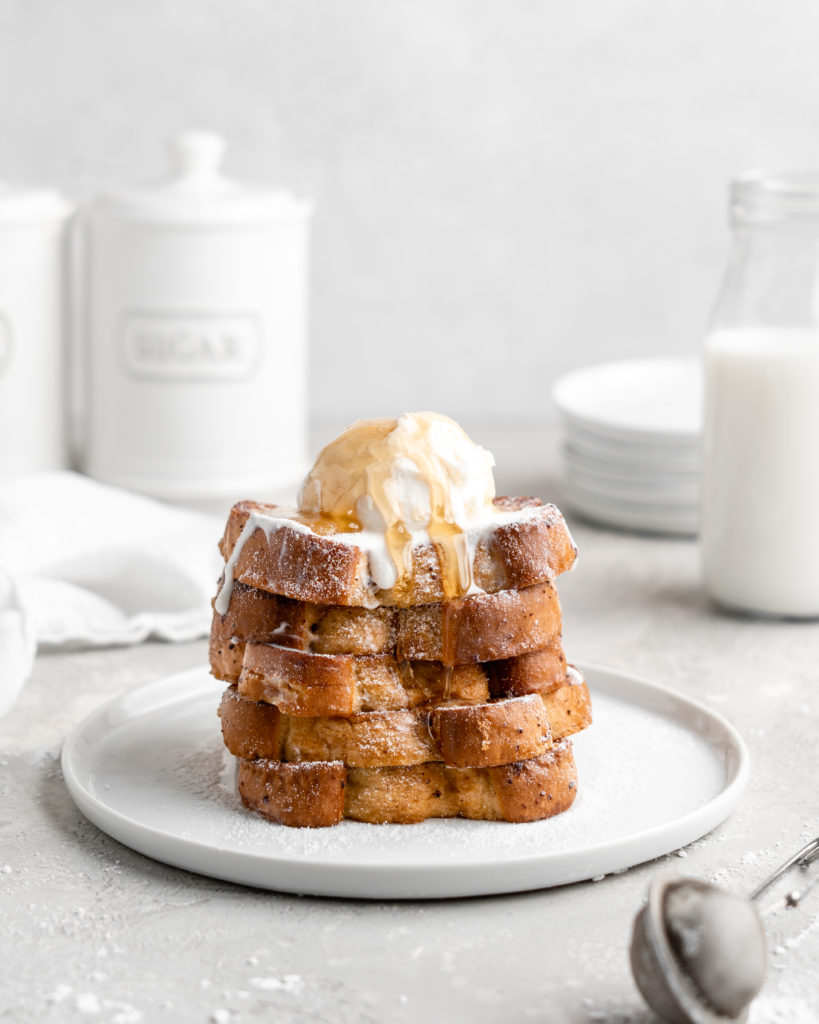
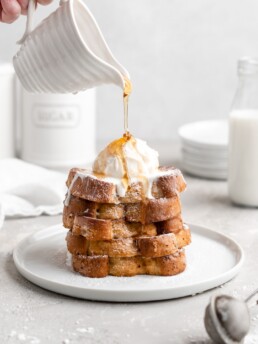
Get the Recipe: Buttermilk French Toast
Ingredients
- 1 Loaf Very Stale French Bread or Italian Bread,, cut into 3/4″ – 1″ slices †
- 6 Eggs
- 1 cup Full Fat Buttermilk, ††
- 1/2 cup Half & Half
- 1/3 cup Sugar
- 1 tbsp Grand Marnier
- 1 tsp Vanilla Extract
- 1 tsp Cinnamon
- Dash of Nutmeg
- Pinch of Salt
Instructions
- Preheat oven to 375°F. (Optional, if baking after).
- In a bowl, whisk egg until well beaten. Using a sieve, strain eggs to remove any large chunks. Then add remaining ingredients to the eggs, whisk until well combined. Transfer custard to a large baking dish (around (9″x13″) for soaking the pieces.
- Prepare a baking sheet by placing a wire cooling rack over top. Place bread slices into custard batter, soak for 30-40 seconds per side. Place soaked bread slices onto the wire rack that is over top of a baking sheet. Allow bread to rest on racks for around 5 minutes, while you preheat your pan.
- Preheat a large frying pan. When hot, add ½ tbsp of butter and ½ tbsp of oil. When butter has melted and bubbles have dissipated, add bread slices (do not overcrowd the pan). Cook about 3 minutes per side, or until golden brown.
- Optional: Place bread back onto rack after cooking. When all slices have been fried, put the rack directly into the oven, and bake for 5 minutes.
Notes
Source: Adapted from Martha Stewart

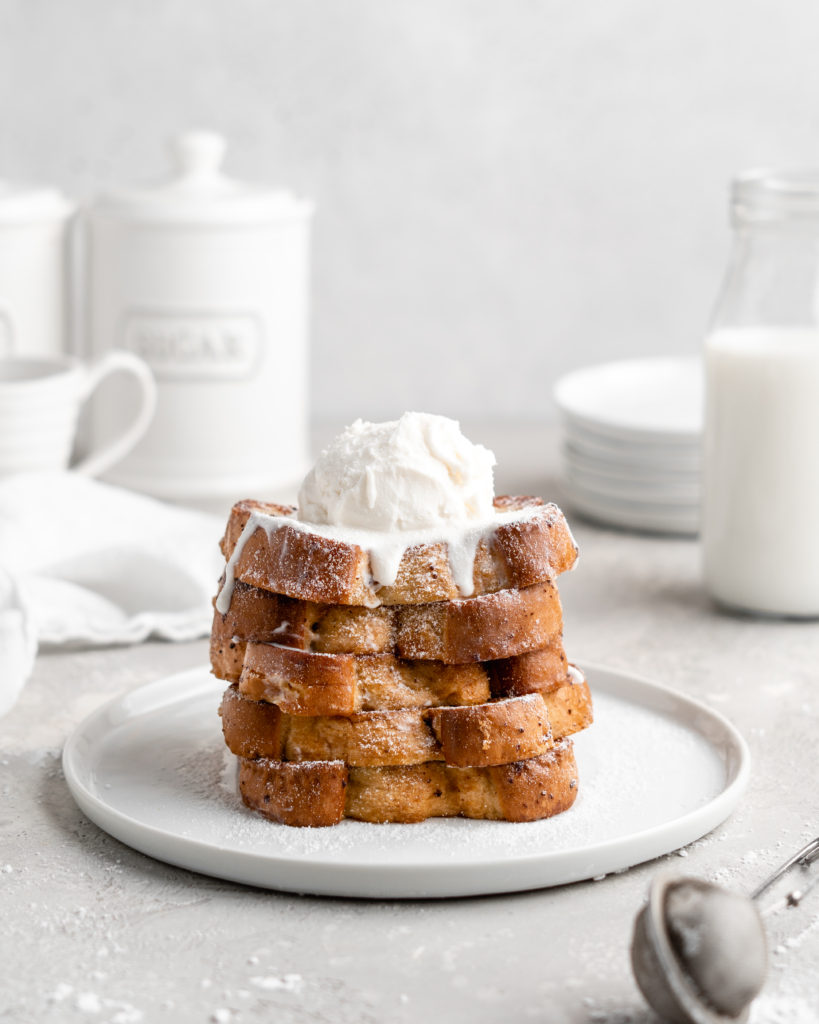
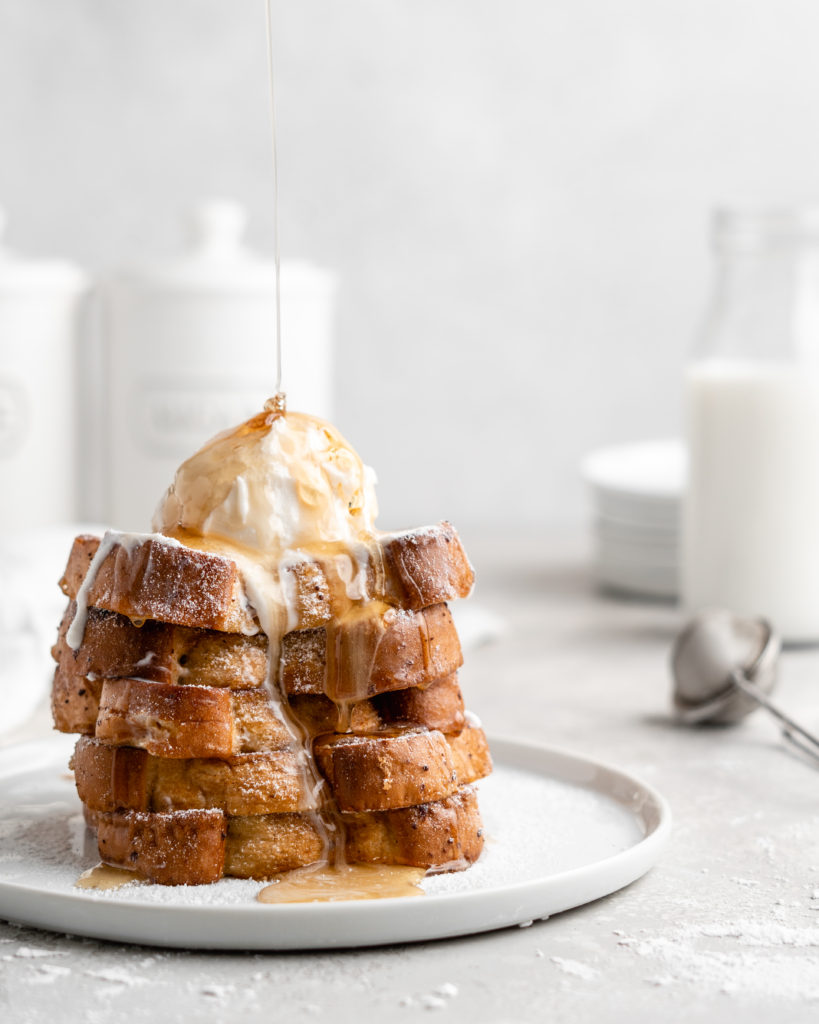

Hi, what is Half&Half?
It’s 10% cream! You can use light (6%) Cream as well!
what’s the purpose of the half &half?
The purpose of half & half is that its a richer dairy (more fat), which creates a richer custard to soak the bread in. This makes for a more tender and flavorful french toast.